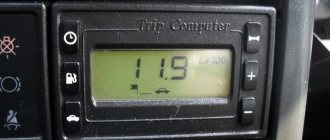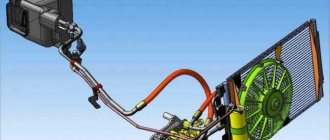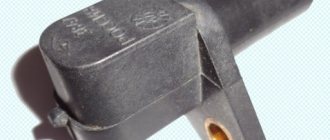VAZ-2112 is a compact car manufactured in 1999, produced at the AvtoVAZ plant in Tolyatti. The hatchback of the same name is one of the modifications of the “ten” VAZ-2110 in a sedan body. A station wagon was also produced on the basis of this model. The car was produced until 2008; on the VAZ-2112 assembly line it was replaced by the more modern Lada Priora hatchback, which is the successor to the entire “tenth” family. In addition to the five-door hatchback, the VAZ-2112 also had a three-door Coupe modification. This version was produced in limited edition.
VAZ 2112 in detail about fuel consumption
When buying a car, the owner is interested in the question of fuel consumption. The fuel consumption of the VAZ 2112 16 in comparison with other models of this car brand is considered economical and acceptable. But it is worth considering that even the driver depends on gasoline consumption for a certain distance. To understand this issue in more detail, it is necessary to consider all the reasons and nuances that affect the decrease or increase in fuel consumption. The actual fuel consumption of the Lada 2112 in the city is approximately 8 liters per 100 kilometers.
If your car's engine uses more fuel, then you need to find out all the direct factors that influence this.
Fuel consumption at idle
When working with a stationary vehicle, fuel consumption depends on the following factors:
- cylinder block and throttle body temperatures;
- condition of injector nozzles and air filter;
- settings of the program recorded in the memory of the control unit;
- general condition of the engine piston group and gas distribution mechanism;
- degree of load on the crankshaft.
For example, the fuel consumption of a VAZ-21124 during a cold start in winter (temperature -20°C) reaches 1.5 liters per hour. As the engine warms up, the control unit adjusts the mixture composition, reducing the parameter to the standard 0.7-0.8 liters. Turning on electrical consumers (for example, a powerful sound system or high beam headlights along with fog lights) increases the load on the generator and automatically increases the idle consumption to 1-1.1 liters per hour.
Average fuel consumption values for VAZ 2112
When purchasing a car, you must immediately know the average fuel consumption of the engine under three main conditions.
The first is the fuel consumption of the VAZ 2112 on the highway, which averages from 9 to 10 liters. In rural areas, off-road - from 9.5 liters. In a combined cycle, fuel consumption on a VAZ 2112 should be at least 7.7 liters. If your VAZ car requires much more, then you should pay attention to the following points:
- like driving style;
- engine's type;
- car mileage;
- specifications;
- fuel quality.
Driving maneuverabilityVAZ
The first thing auto mechanics advise you to pay attention to when fuel consumption is high is your driving style. Lada is a car that does not tolerate slow acceleration or slow acceleration.
Engine type VAZ
The 2112 hatchback has a 1.6-liter fuel-injected engine with 16 valves. A 5-speed manual transmission is installed. For such an engine, the fuel consumption of the VAZ 2112 (16 valves) is an average of 7.7 liters.
As for the engine type. If the VAZ 2112 fuel consumption per 100 km exceeds 8 liters, then you need to pay attention:
- fuel filter;
- valve filter;
- nozzles;
- candles;
- valve;
- oxygen sensor.
You should also check the condition and adjustment of the electronics and its reliability.
Computer diagnostics of cars
The gasoline consumption of a VAZ 2112 per 100 km in the city will be up to 7.5 liters, only when the car drives smoothly, without jerking, switching to different speeds, and also choosing the optimal driving style in summer and winter. If there are shiny deposits on the probe tube, this indicates that there is a lot of lead in the fuel used, and it is better to refuse to use such gasoline, and accordingly, change the brand of gas station.
Car mileage
A very important point is the mileage of the car, as well as its condition. If this is a new car from a showroom, then all average fuel consumption indicators should match. If the car’s mileage has exceeded 100 thousand kilometers, then gasoline consumption may exceed the average.
It also depends on where the car was driven, on what roads, at what pace, and whether the engine was repaired. To find out exactly what gasoline consumption on a VAZ 2112 will be under your driving mode, fill the tank with 1 liter and check how far you can drive. Car mileage is the total number of kilometers that the car has traveled without repairing the engine and its main components.
Influence of time of year, temperature and sensor serviceability
Again, a lot depends on the time of year. In winter, every vehicle uses much more fuel. This is due to the long warm-up of the engine, the condition of the road surface, and periodic slipping. In the summer months, the basic consumption rate decreases if you do not keep the windows open when driving at high speeds.
Another reason has to do with the functioning of the sensors. If they are set incorrectly, they will not be able to correctly calculate the sufficient volume of the air-fuel mixture, as required by the engine control unit. This is an oxygen sensor, an air metering sensor and others. As a result, an overly enriched mixture begins to form, which empties the tank in a short time.
The first cars in this series have a carburetor engine, which can be manually adjusted to reduce fuel consumption. It will not be possible to set up an injection engine in the same way. However, it is periodically necessary to look into the injectors of the power unit and check whether they are clogged. If clogged, they begin to spray more gasoline, while the quality of the working mixture remains low.
It is known that the normal temperature of the power unit should be in the range of 90–100 degrees Celsius. As soon as it starts to overheat, the mixture becomes unnecessarily discharged. Engine power immediately drops, which leads to excessive fuel consumption. There is also the concept of “instant fuel consumption,” which is reflected on the trip computer screen. But unfortunately, not all cars are equipped with it. This indicator is influenced by the speed of movement and engine speed. In some cases, it can amount to tens of liters per hundred kilometers, but you should not be afraid of this, since we are talking only about the every second value when accelerating the car in low gears.
With this we will say goodbye. Subscribe to blog updates to continue receiving interesting newsletters. See you again, dear car enthusiasts!
Sincerely, blog author Andrey Kulpanov
Place for contest advertising Andrey Views: 17059 3 Likes Share 1 comment
A headache for motorists is high gas mileage. Prices at gas stations regularly increase, so more and more of the family budget has to be spent on fuel. Although sometimes it is enough to devote a couple of hours to your iron horse for diagnostics with easy repairs, and this time will return in the form of saved liters per hundred kilometers.
Of all the consequences that affect efficiency parameters, it is customary to distinguish two main reasons for high fuel consumption:
- direct (poor performance of individual components or elements, as well as their complete failure to operate);
- indirect (factors that are largely not directly related to design changes during operation).
Machine Specifications
A Russian passenger car with a hatchback body with easy maneuverability, it has fairly good factory technical characteristics. In order for fuel consumption to remain constant and not increase, it is necessary to monitor the technical characteristics of the entire vehicle. Inspection at service stations, as well as computer diagnostics will help you with this.
Fuel quality
The fuel consumption at idle speed of the VAZ 2112 is affected by the quality of gasoline, as well as the ketone number of the liquid being refilled. An experienced driver can safely say that he noticed how fuel consumption changed not depending on driving style
, not from the engine or even from the filters, but from high-quality fuel. When driving a VAZ 2112, you should take into account its mileage, as well as what you put in the tank. Accordingly, the amount of fuel consumption is determined from this.
How to reduce fuel consumption
Real fuel consumption on the 16 valve Lada 2111 is about 6 liters per 100 km
. In order not to exceed the threshold of this figure, it is necessary to carefully monitor the technical characteristics of the car, the engine and the entire operation of the machine.
Mandatory actions for caring for the operation of the motor system
- replacing the fuel filter;
- cleaning injectors;
- timely oil change;
- generator cleaning.
Computer diagnostics will help identify causes and reduce fuel costs. It is also necessary to adhere to traffic rules and calm, moderate driving.
How to regulate fuel consumption on a VAZ 2112
We have already considered the factors and reasons that affect the use of gasoline in the VAZ 2112. Now you need to know what needs to be done to prevent gasoline consumption from increasing or how to reduce it. The main points to prevent increased fuel consumption are:
- constantly change the fuel filter;
- monitor the operation of the engine system;
- change candles that become black and oily over the years - non-functional;
- watch the condition of the fuel pump mesh so that it does not fall into the glass;
- The catalyst and exhaust must function.
By adhering to these rules, you can save on fuel costs for the VAZ 2112 by 7.5 liters.
Basic rules for reducing gasoline consumption
An attentive driver must constantly monitor all indicators of the car. Monitor the oil level, monitor engine operation, and monitor all filters and strainers. If you bought a car that has already traveled a certain number of kilometers and its fuel consumption exceeds 10 liters, then you should immediately take the following actions:
- change oil (adjust level);
- replace the filter;
- check the quality of gasoline;
- observe the performance of the fuel pump;
- regulate driving maneuverability.
Reasons for increased consumption
The on-board computer screen shows increased fuel consumption
The increase in engine fuel consumption on the VAZ-2112 is identical to all other engines of any family of cars. But it is worth considering this issue in more detail. So, what are the reasons for the increase in consumption:
- Fuel system malfunction.
- Problems with the injector.
- The fault lies in the catalyst.
- Air filter dirty.
- Engine temperature.
- Sensors and ECU.
Once the reasons have been determined, you can begin step-by-step repairs.
Methods for solving the problem
To eliminate increased fuel consumption, it is worth understanding the design features of not only the main power unit, but also the auxiliary systems on which the operation of the engine as a whole depends. Thus, several systems become the causes at once. But how can we determine where exactly the malfunction occurred? To do this, consider the sequence of diagnostic and repair actions for systems.
Sensors and ECU
When any engine malfunction occurs, the first place you need to “climb” is the electronic control unit.
Often, errors are hidden here, and you can also see where the problem is hiding. To perform diagnostics, you need to connect via a tablet or laptop to the “brains” of the car using a USB – K-line cable.
Diagnostics through the instrument panel of VAZ-2112
The explanation of the errors that could be seen in the video is given below in the picture.
ECU error codes and their interpretation
The first reason may be accumulated errors in the block itself, where the commands already contradict each other, and the injectors began to supply an increased amount of the fuel mixture. The treatment is simple - resetting errors or installing a new operating system. Many car owners recommend Paulus.
If resetting the ECU errors did not help, then it is worth checking the functionality of the sensors that are responsible for the air-fuel mixture, namely:
- Mass air flow sensor.
- Lambda probe.
- Throttle position sensor.
- Temperature sensor.
Engine control circuit and sensors
It is these sensors that can cause fuel consumption to increase. If diagnostics show that one of them is faulty, it must be replaced. If, however, the consumption remains the same, you need to move on and look for the problem in another unit.
Fuel system
It is in the fuel system that the mystery of increased engine fuel consumption may lie. First of all, you need to check the pressure in the fuel pipes and fuel rail. Several parts that have failed for various reasons can contribute to this effect.
Dirty fuel module mesh
The first two items to check are the fuel pump and the fuel filter. Dismantling the fuel module may be a clue, since the filter mesh could simply be clogged. But the filter is not visible, so you just have to change it. Low-quality fuel, which is saturated in the modern gasoline market, as well as low-quality spare parts can cause this unit to fail ahead of time.
Fuel consumption VAZ 2112
Onion rings stuck between car seats don't smell better over time.
VAZ 2112 is a hatchback version of the 2110 model, which resulted in a separate model. It has been produced since 1999, and stopped coming off production lines in 2008. The car could be either a five-door or a three-door. The model differs from the sedan in a shortened body, thanks to which control and acceleration have become better, as well as a trunk enlarged due to special technologies, the volume of which is almost 400 liters.
VAZ 2112 1.5 8v, 1.8
Other power units were also installed on VAZ-2112 cars. The first models were equipped with an injection 8-valve 1.5-liter VAZ-2111 engine, which had successfully proven itself on models of the “ninth” series, capable of producing power of 77 hp.
In addition, a modification of the VAZ-21128 was produced in a small series. It was equipped with a powerful 1.8-liter injection engine capable of producing 105 hp. and a torque of 162 Nm. Without exception, all engines were equipped with a 5-speed manual transmission.
Official data (l/100 km)
The VAZ 2112 was equipped with several types of engines. In fact, there were only three of them, but due to various modifications their power varied greatly. The first engine is 1.5 liters. The version, which had a total of 8 valves, could develop a power of 72 horsepower. Fuel consumption per 100 km here was at around 7.2 liters. The 16-valve version showed slightly more power – 92 hp. Gasoline consumption for this configuration was also around 7 liters.
The next engine is 1.6 liters. The eight-valve configuration produces 81 horsepower, and the sixteen-valve configuration produces 90 hp. These engines have increased consumption, prescribed at 8 liters. Well, the largest engine is 1.8 liters. It has only one version, with a capacity of 98 horsepower. Its average consumption was 8.5 liters. All engines were paired with only a manual transmission operating in five modes.
Key points regarding gasoline consumption
The main indicator that affects the fuel consumption of a car engine is engine volume. Gasoline consumption for the VAZ 2111 on the highway with a 1.5 - 5.5 liter engine, and with a 1.6 - 5.6 liter engine.
Fuel consumption for a VAZ 2111 in the city with an engine of 1.5 - 8.8 l, 1.6 - 9.8 l.
As you can see, the larger the engine volume, the higher the fuel costs. Motor modifications are designed for better performance and efficiency. In a combined cycle, the engine uses up to approximately 7.5 liters. Also very important is the maneuverability of the ride, the character of the driver. With calm, moderate driving, you can save up to 1.5 liters on the highway and in the city.
Owner reviews
“I decided not to spend money on my first car and bought a VAZ 2112. I’ve been driving it for 10 years. If you take care of the car, as I do, then it will live for a very long time. He never let me down, although the situations on the roads were different. The only thing I don't like is the design, it's too simple. But everything in the cabin is great. There is a lot of space, it is well equipped, and there is a lot of useful stuff on the dashboard. I will also note the build quality, which is not typical for our cars. The engine is peppy and drives well, both on regular roads and off-road. Too bad it's a big expense. I spend up to 11 liters of fuel,” writes Georgy from Krasnodar.
This review was left by Kirill from Rostov:
“To my great regret, my old car broke down for good. I urgently needed some kind of car to carry out normal everyday tasks. There wasn't a lot of money, since most of it was spent on repairing the previous car. I had enough for the VAZ 2112. I can’t say anything bad about the car, it’s a worthy model. There is plenty of space for both passengers and things in the trunk. The engine allows you to drive at a decent speed on the highway, and also feel comfortable in the city. It uses a lot of fuel, but the car is good.”
“My father gave me the car after he bought himself a new foreign car. My joy knew no bounds, since I received my license a long time ago, and there was nothing to constantly practice on. I like everything about the car. A pleasant rounded design, a modern and spacious interior and a peppy engine evoke only positive emotions. I was impressed by the sound insulation, which does not allow sounds from the street to pass through at all. I travel very often, so I use a lot of fuel. In the summer I spend up to 12 liters in the city, a little more with air conditioning. In winter it’s about 13,” notes Nikolai from Yekaterinburg.
And this is what Artem from Smolensk writes about his car:
“I bought the car from a dealership in 2005. I drove it for almost five years and decided to sell it. But I did this solely in order not to spoil the impression of our cars, since by this period of use various problems usually begin, and I don’t want to tinker with the car. I was completely satisfied with it and saw no shortcomings at all. I would like to note that the interior was quite modern in terms of equipment, which made us proud of our auto industry. Here you can find high build quality, good sound insulation, and pleasant finishing materials. Consumption varies greatly and depends on the time of year. In winter, on average, it was 11-12 liters, in summer – up to 10.”
“Before I was twelve, I had several cars, but there were problems with all of them. However, here, to my surprise, everything was smooth throughout the entire time of use. I have never been to a service center, I changed all the consumables myself. I was surprised by the technical equipment, which is characterized by high reliability and good cross-country ability on any road conditions. The engine would be a little more powerful, and you simply couldn’t find a better car, especially at such a low cost. One moment, of course, spoiled the impression a little. This is a consumption that could reach 13 liters in the city and 10 on the highway. This is too much for such a small engine,” writes Vladimir from Tver.
Driving maneuverability VAZ • Engines with 16-valve VAZ 21124
| What gasoline to pour into a 124 VAZ engine When purchasing this model, regardless of the type of engine, which can be either 8 valves or 16 valves, everyone, without exception, is interested in the fuel consumption of the VAZ-2110 car and, of course, the technical characteristics of the iron four-wheeled friend . The first reason may be accumulated errors in the block itself, where the commands already contradict each other, and the injectors began to supply an increased amount of the fuel mixture. |
| VAZ 21124 increased fuel consumption | Tricks of Life Its characteristics have gone so far that it shows anything but the current air consumption, which is why the client complains about excessive fuel consumption. Some owners have much better fuel consumption, but often there is some problem with the engine or some element of the fuel system. |
- Sergey, Tomsk. I purchased the car in 2007, just before the release of the Priora. I chose the top version with a 1.8-liter engine. The car is very dynamic and economical, consuming no more than 10 liters per 100 km in the city.
- Igor, Nikolaev. The car was manufactured in 1999 and was purchased second hand in 2008. Now the odometer of my dvenakha has 78 thousand mileage. A hatchback with a base 1.5 engine, but despite this it is very dynamic in the city. Handling is poor, but this is not a problem for a budget car.
- Moreover, there are many more advantages. Take, for example, a convenient trunk - the main advantage of a hatchback compared to a sedan. It is this version, as for me, that looks much sportier and neater than the fat-assed “ten”. My car in the city spends about 7-8 liters if you drive no more than 60 km/h.
- Peter, Rostov. In 2022, my “twelfth” will turn 10 years old. The version with a 1.6-liter engine has good acceleration potential, and this is very well felt in the city. The interior is comfortable and cozy, despite the cheap materials. All instruments and buttons are at hand, everything is quite thought out. I can say the same about the average consumption of 9.5 liters per hundred.
- Nikolay, Kharkov. Great car for its time. In any case, much better than any classic. It can even compete with Granta, although this is a completely different class. I use the hatchback mostly on the highway, and I settle at 7-8 liters per 100 km.
- Peter, Novosibirsk. I bought a hatchback specifically to transport long items and small household appliances - that’s my job. My “twelfth” copes with the assigned tasks perfectly well. There were no problems with breakdowns while it was under warranty. Now it’s gone, I don’t repair major breakdowns myself. You have to turn to friends or, as a last resort, visit a paid branded service. But everything there is relatively inexpensive, so the financial losses from this hatchback are not that great. In addition, fuel consumption did not disappoint - in the city it turns out to be about 9-10 liters with a 1.6 engine.
- Alexey, Penza. I got the Lada twelfth from my brother, who bought himself a Vesta. I was very happy because I graduated from driving school. The car is worthwhile, easy to repair and use. In general, I won’t say anything bad about my first car. Consumes about 11 liters per 100 km.
- Dmitry, Makeevka. Became the proud owner of a VAZ-21124 in 2006. The car is from the latest batch, almost free of factory problems. My mileage is 100 thousand, so I have already changed quite a lot of parts. Balls, silent blocks, front and rear suspension struts - I still managed to buy all this under warranty. Replaced the entire clutch basket and installed a new gearbox. As you can see, many parts have worn out, including large ones. But all components were replaced according to regulations, and there were never any unpredictable repairs. The 1.6-liter engine did not disappoint. It pleases me with its efficiency in the city. If you drive at an average speed of 80 km/h, you get no more than 11 liters.
- Fedor, Kyiv. The car is excellent, a comfortable vehicle with a convenient trunk. The family likes it. In the city I get 9.8 liters, on the highway I get 7.2 liters. Odometer information.
- Vasily, St. Petersburg. I bought the car as a gift for my wife, but she constantly complains about it. Like, this is not a woman's car. It constantly breaks down, something rumbles and rattles everywhere. But it’s my own fault, I decided to save money and bought a used version. In general, I’m thinking of taking this one for myself and giving my other half something foreign. I tested the twelfth more than once, and was satisfied. A car with a 1.5 engine consumes about 8 liters in the city.
- Yaroslav, Sakhalin region. My parents gave me a car for my birthday. That day, my heart seemed to overflow with tears of happiness, I immediately got behind the wheel and drove off, leaving the guests behind. I crashed into a pole, but it’s good that the speed was low. Got away with a broken headlight. Since then I have been trying to control my emotions. The hatchback consumes about 9 liters in the city.
What is the fuel consumption per 100 km on a VAZ-2112: passport data and real data
Car : VAZ-2112. Asks : Denisov Sergey. The essence of the question : What is the standard fuel consumption for a VAZ-2112?
Good afternoon, please tell me what fuel consumption should be on a VAZ-2112? I would like to know the exact data, or at least close to it! And what to look for if it seems to me that it is slightly enlarged.
Troubleshooting the ignition module Engine VAZ 21124 16 valves
The installation of a distributed fuel injection system made it possible to increase engine power and reduce fuel consumption by 8, which, however, is almost invisible to the average driver. Our car is equipped with a Bosch mass air flow sensor 0 280 218 037 and we recommended the client to purchase a Bosch sensor.
| Engine | Consumption (city) | Consumption (highway) | Flow (mixed) |
| 1.6 MT (manual) | 9.5 | 5.8 | 8.0 |
VAZ-2112 engines
The VAZ-2112 car is a popular hatchback from AvtoVAZ. From the factory it was configured with different engines:
- 16-valve , 89-horsepower, with a displacement of 1.6 liters, marked as 21124 . (A distinctive feature is that this engine does not bend the valves when the timing belt breaks).
We will make a replacement on this engine (21120)
All engines are paired with a five-speed manual gearbox.
Judging by the great popularity of this car among car enthusiasts, it is distinguished by high reliability and high performance characteristics.
Engine design
AvtoVAZ engineers understood that by the time of mass production of domestic 10th generation cars, the power units of the eighth and ninth generation would be very outdated. The trends of the world automotive industry demanded an increase in the power and environmental friendliness of manufactured engines. After all, European manufacturers Volkswagen, Opel, Renault produced engines much more powerful than the domestic AVTOVAZ. But in addition to power, European engines were more economical and environmentally friendly. AvtoVAZ engineers were faced with the task of creating something similar.
There were several ways to get what you wanted. In order to achieve clean exhaust gases, an unconditional decision was made to switch to distributed injection. In addition to the cleanliness of the exhaust, this solution partially solved the issues of increasing power and efficiency.
To obtain the desired power, distributed injection alone was not enough, it was decided to increase the amount of horsepower by increasing the engine size. The volume of 1.6 liters was achieved by increasing the piston stroke to 76.5 mm, which became possible after reconstructing the engine height and using a crankshaft with a large crank. The cylinder diameter has become larger, now it is 82 mm. But this modernization was not enough.
Average fuel consumption
Fuel consumption on the VAZ-2112 shows average values based on the specific type of fuel, and judging by this, such readings vary.
Thus, for different types of fuel, the average readings look like this:
- AI-92 – 9.12 l.100 km.
- AI-95 - 7.4 l .100 km.
- AI-95 Premium - 6.5 l. 100 km.
- AI-98 - 6.0 l. 100 km.
- Propane butane gas - 9.53 l. 100 km.
These indicators have average values and may differ from driving style, quality of the road surface and places of travel, because trips around the city and on the highway vary significantly in terms of fuel consumption.
Why is consumption increasing?
In order to understand why fuel consumption has increased, significantly or not, it is impossible to immediately and accurately answer this question. The first step is to find out which of the systems has failed or has a malfunction. So a significant contribution to this can be made by the air filter, mass air flow sensor, injectors or spark plugs.
VAZ 2112 1.5 16 valve 92 hp
Since 2001, VAZ-2112 cars in the VAZ-21120 version have been equipped with a 1.5-liter VAZ-21120 injection 16-valve engine. This engine developed 92 hp. and a torque of 133 Nm and was considered one of the most popular engines in the LADA 110 family. The engine was paired with a 5-speed manual transmission.
Gasoline consumption VAZ 2112 1.5 16 valve 92 hp per 100 km. Reviews
- Alexey, Moscow. I bought the car in 2013 - it was my first car. I didn’t show off too much, I took the domestic auto industry - a VAZ-2112, with a one and a half liter 16v engine. For the money it's a normal car, if you don't worry about it and take care of it. I've already driven 40 thousand km on it - it's inexpensive to repair, the main thing is that it's not the engine. Consumption is quite high - in the city on average 9 l/100 km, and if you drive - then all 12 liters.
- Oleg, Prokopyevsk. I took the VAZ-2112, “born” seven years ago, for one simple reason - my RAV4 broke down, and for a long time. So we had to look for a car to go to work, and... All the money went into repairs - I had to take it cheaper. I was surprised that in fact the car turned out to be not as wretched as everyone thinks - yes, it is much inferior in terms of comfort, but it didn’t break down much, and carried me in any weather without problems. Consumption is quite reasonable - from 6 liters on the highway to 12 liters if you want to drive around the city.
- Mikhail, Moscow. I love my “two-piece”, which I bought in 2007. I took it from the first owner - a car produced in 2003, with a 1.5 l 16v engine, 90 horses. It was completely stock, but I put a lot of effort and money into making it into a sweetie. By the way, I’ll say right away that the car drives without problems for five years, but then everything starts to break down at once. Fuel consumption depends very much on how you drive. If you calmly and without putting pressure on your slippers, it’s stable 7.5-8.0 liters per hundred square meters. If you heat it - 12 liters safely.
- Evgeniy, Kazan. I purchased the “twelfth” at the beginning of 2014 - my first car after passing my license. I drove it for six months and sold it - that’s what I had to do. I’m completely satisfied - maintenance is much cheaper than foreign cars, and gasoline consumption averages ten liters per hundred kilometers in the city.
- Sergey, Mezhdurechensk. Fuel consumption of the VAZ-2112 greatly depends not only on driving style, but also on the time of year. For comparison, if in the summer in the city there is a stable 8-9 liters, then in the winter it’s never less than 12, or even 15 liters if it’s frosty. On the highway, by the way, it doesn’t really matter – 5.5 in summer, 6.0 in winter.
- Kamil, Novokuibyshevsk. VAZ-2112, engine 1.5 16V, 90 hp, 2004. The downside is that upon purchase the body began to rust, and after six months the rest of the sores appeared. But we are not afraid of difficulties - the car has been in the garage for six months and is as good as new - all that remains is to make the body. Consumption on average is 6.5 -7.5 liters per hundred square meters, no more.
- Anatoly, Barnaul. The car, like the entire domestic auto industry, is rare guano. Maybe I got one - but it’s just tough. I bought it in 2010, manufactured in 2000. It’s clear that it’s old, but even an old car can’t break down like that. I suffered with it for about a year, threw the same amount into it as I bought it for and barely sold it at a loss. Plus it consumes a lot of gasoline - in the city it’s at least 9 liters, on the highway about 7 liters.
What is the approximate fuel consumption per 100 km on a VAZ-2112
Considering the fact that price tags at gas stations change only in one direction - growth - the fuel consumption indicator today is one of the main ones when choosing a car.
In addition, during operation, many owners wonder whether their iron horse eats too much. It should be noted that domestic cars, such as the VAZ-2112, are considered inexpensive to operate. Their design is very simple, without any complex electronic devices, and the prices for spare parts are quite reasonable. Accordingly, engine efficiency begins to come to the fore.
Turbine for VAZ 21124. Engines with 16-valve VAZ 21124
If you take care of repairs in time, some elements can simply be repaired or cleaned, but they do not have to be completely replaced, which is in the driver’s interests. In contrast to the module, the absence of a spark on the spark plugs with a dual ignition coil may indicate a malfunction of not only these coils, but also a malfunction of the electronic engine control unit.
| Parameter | Meaning |
| Length, mm | 121,0 |
| Upper head hole diameter, mm | 21,978 – 21,982 |
| Bottom head hole diameter, mm | 51,330 – 51,346 |
| Weight, g | 689 |
VAZ-2112 – what should be normal fuel consumption?
In order to find out how much gasoline the “twelfth” consumes per hundred kilometers, you should refer to its passport data. The manufacturer, in particular, gives an average figure of 7.5 liters per hundred. However, a car's fuel consumption depends on many factors. For example, the Volzhsky Automobile Plant installed three types of engines on the “twelfth”:
- 21121 – 1.5-liter, 80 horsepower, 8 valves;
- 21124;
- 21120.
The last two engines are 16-valve. The volume of 21124 is 1.6 liters with a power of 89 horsepower. It should be noted that here, if the timing belt breaks, the valves do not bend. Finally, 21120 is a 1.5-liter engine with 93 horsepower.
A distinctive feature of this power unit is the steel receiver. One of the disadvantages is that the valves bend when the timing belt breaks.
It should be noted that the consumption of each of these engines also depends on the brand of fuel. For example, when driving an AI-92, this figure is 9.12 liters per 100 kilometers. By filling the tank with higher octane fuel, you reduce its consumption. In particular, with AI-95 gasoline, consumption is reduced to 7.4 liters. An even more noticeable effect in terms of savings is noticeable on premium varieties. In particular, by filling AI-95 Premium gasoline, you will reduce fuel consumption to 6.5 liters. All data is given for the “mixed cycle” mode.
It should be noted that it makes no sense to cite the figures announced by the manufacturer. Real consumption always differs greatly from the passport data. Also, do not forget that driving in urban conditions with heavy traffic significantly increases gasoline consumption. At the same time, on a suburban highway you can travel most of the way in 5th, direct gear. Accordingly, the appetite of the iron horse is significantly reduced.
What kind of gasoline to pour into a 124 VAZ engine
Here is a brief description of the VAZ-21124 car taken from this site www.autonet.ru/
Technical characteristics of Lada (VAZ) 21124
Free and emotional VAZ 2112 - the sports-style version demonstrates modern technologies. At the same time, the 5-door hatchback remains a true representative of the LADA 110 family - a comfortable, practical and reliable car, attracting with its elusive combination of spacious interior and luggage compartment with partial or full rear seat layout and compact external dimensions. If you enjoy a sporty style, if driving helps you take your mind off the worries of everyday life, then the 112, with its enhanced agility and expressive aesthetic design, exudes the pure dynamism of modernity, is the car for you. The photo shows the main characteristics of the car.
As a result, when filling 41 liters of AI-95, we spend approximately 1,600 rubles, and have an average fuel consumption of 5.5-6 liters when driving along the highway at speeds of up to 120 km/h.
When filling 41 liters of AI-92, we spend a little less than 1,500 rubles, and have an average fuel consumption of approximately 6-6.5 liters when driving along the highway at speeds of up to 120 km/h. This is purely my guess (based on the consumption of 41 liters of AI-92, I will write down how many kilometers were traveled and the approximate average fuel consumption).
This difference in the octane number of gasoline does not affect the dynamics of the car.
For comparison: the last time I filled up 39 liters of AI-95. With this amount of gasoline, a distance of 475 kilometers was covered and approximately 30 liters of gasoline were consumed (kilometers and the amount of fuel consumed according to the BC); the average gasoline consumption per 100 kilometers was 6.3 liters (again, according to the BC). 425 kilometers were covered along the highway during the trip to the village. Belaya Berezka and back to Sescha. I covered 50 kilometers while driving around my town over the course of a week. Well, here’s a photo of BC’s testimony from the trip to Belaya Berezka.
When refueling AI-92, we save in monetary terms, but this saving results in an increase in fuel consumption by a small amount, from approximately 0.5 liters to 1.5 liters per 100 kilometers.
VAZ fuel consumption.
VAZ fuel consumption is always acceptable. The developers are seriously thinking about reducing fuel consumption for different VAZ brands.
VAZ cars are domestically produced cars. VAZ is a Volga automobile plant, it is located in the Samara region in the city of Tolyatti. VAZ cars are distinguished by moderate fuel consumption and affordable prices.
Data on VAZ fuel consumption are described below in the table on fuel consumption of VAZ cars. VAZ cars are not only a means of transportation, but also an integral part of everyday human life.
Fuel consumption of a VAZ depends on its modification (brand), driving style and time of year. The table below shows the average fuel consumption of the VAZ brands of the 2107, 2114, 2110, 2106, 2112, 2109, 2115 family.
VAZ 2112 1.6 8cl. 81 hp
The version with the VAZ-21114 engine received the factory index VAZ-21211. It was a 1.6-liter 8-valve fuel-injected engine capable of producing 81 hp. and a torque of 129 Nm. The engine had a number of shortcomings, so after some time it was replaced by a more reliable and economical 16-valve modification.
Reviews about fuel consumption of VAZ 2112 1.6 8kl. 81 hp
- Roman, Sochi. I bought it from one representative of the mountain people in 2012 - it was tuned to the best of my ability, forward flow, ProSport optics, new seats, lowered suspension, low-profile tires, completely noise-free, and the like. It roars like a beast, and the engine is a regular 1.6-liter 8-valve engine. In general, there is an external gloss, but there is little sense. Consumption 8-9 liters, up to 10 maximum. I drove it for six months and sold it to the same “ara-tuning” lover as the one from whom I bought it.
- Alexey, Slavyansk-on-Kuban. I bought my VAZ-2112 in 2003. I took it with a 1.6 liter engine - I think it is better than 1.5 liters. I drove it for almost 10 years – it was like my own. An excellent car for the city and suburbs, fuel consumption is up to 9 liters, on the highway generally 6 liters.
- Nikolay, Ulyanovsk. Lada “twelfth”, 2004, with a 1.6 liter eight-valve engine. At first I was delighted after the purchase, but very, very soon I had an epiphany. The only plus is the high ground clearance and that’s it. Everything else is rare hemorrhoids. The interior is completely miserable, everything rattles and knocks, something constantly breaks, and normally no one repairs this squalor at all. Gasoline consumption is normal - 8-9 liters consistently in the city, on the highway 6.5 liters.
- Maxim, Noyabrsk. Don't be fooled by the fact that spare parts can be bought at any store. Yes, you can buy them there - but they are of even worse quality than Chinese ones. You buy, install, and after two or three months you have to buy and install again. And so on with each node. The only thing they did right was the ground clearance; they made it quite high for our roads. Expected consumption – highway from 5.5 to 6.5 liters, city from 7 to 10 liters.
- Grigory, Bratsk. Everyone complains about the domestic auto industry, but I like the “two-wheeler”. I bought it back in 2006 - a three-year-old VAZ-2112 with an 8-valve 1600 cc. A couple of years later I sold it and took the same one, but 16v. I will say that I didn’t see much of a difference either in consumption or in dynamics - my first “two-wheeler” was peppy and consumed 7-8 liters of gasoline on average in the city.
Table of fuel costs for VAZ brands.
The table describes the average costs for different VAZ brands . Fuel consumption is presented in three types - city, highway and mixed (average) fuel consumption. All data on fuel costs are from the VAZ car manufacturer. For almost all brands of VAZ cars, fuel consumption does not exceed 10 liters per 100 km, with the exception of the carburetor Niva.
Average fuel consumption VAZ
liter/100 km
VAZ has acceptable fuel consumption!
The car is given good dynamics and acceptable fuel consumption thanks to its reliable engine. VAZ has an affordable price for both a new and an old car. Old VAZ brands are acceptable to most people. The new VAZ engine demonstrates extreme efficiency, thanks to which the car has low fuel consumption and a reduced level of harmful emissions into the atmosphere.
VAZ - average quality cars, affordable price and acceptable fuel consumption.
VAZ 2112 1.6 16 cl. 89 hp
The latest and most popular model is the VAZ-2112, equipped with a VAZ-21124 engine. This is an injection 4-cylinder engine with a volume of 1597 cm3, having 4 valves per cylinder. The engine developed a power of 89 hp. and a torque of 133 Nm. It has a modernized design that eliminates the main problems of the 8-valve version, in particular the problem with valve bending
Fuel consumption VAZ 2112 1.6 16 cl. 89 hp per 100 km. Reviews
- Alexey, Chelyabinsk. Sixteen-valve VAZ-2112, 2005. I bought it new, sold it five years later and don’t regret the purchase or sale one bit. During all this time I hardly bothered you, but five years is the deadline for the domestic automobile industry, then sex with the car begins, and why spoil the impression? So I sold it and am happy. By the way, its consumption is less than that of the “ten” - on average I got 6.5 liters in the city, but I drive calmly.
- Timur, Pervouralsk. VAZ-2112, 2007, engine 1.6 16V, 90 hp. For the money, the car is not bad - it’s really made for our roads, and it looks more interesting than the “ten”. But the build quality is a quiet horror - everything that can rattles. In terms of consumption - highway 5.5 l, city 8.5 l, in winter maximum 10 l.
- Semyon, Krivoy Rog. Before the “Dvenakh” there was the Volga 29 - you can’t compare them at all. “Dvenakha” in comparison with it is just some kind of foreign car. I bought it in 2012, four years old. The condition is normal - as normal as it can be for our car. Consumption is from 7 to 10 liters, there is Shumka, nothing particularly knocked. I took it while I was riding and am happy.
- Artem, Salavat. A really simple and problem-free car, no matter what anyone says. Probably one of the most successful AvtoVAZ models. At speed the car is stable, does not throw it, the power of the 16-valve engine is enough for the eyes. Another plus is the high ground clearance; some city crossovers have lower ground clearance. Well, it’s economical - on the highway the consumption is 5.5 liters, in the city from 7 to 9 liters.
- Vitaly, Anzhero-Suzhensk. I bought my VAZ-2112 2007 six months ago. I haven’t really gotten into it yet - I made a Shumka, installed good acoustics, and also replaced the steering rack. There are no problems with consumption - if you heat in the city, then nine liters is the maximum, but if it’s calm - then six or seven liters, no more.
- Kirill, Abakan. "Dvenakha" 2006. Consumption is from 6 to 8 liters per 100 km, and in the city, if you don’t heat it, it’s very economical. In winter, consumption increases by about 2-3 liters, depending on frost.
- Anton, Tyumen. I always liked the “Dvenashki” - but the first time I bought a bad one, it turned out to be after a serious accident, it was hastily adjusted and that’s it, but I wanted to buy a car so much that I didn’t look carefully - I was attracted by the price. Six months later I realized the mistake, but I liked the model itself. Therefore, when choosing the next “two-piece”, I looked more carefully and made the right decision. What I like most about it is the engine - a reliable and simple sixteen-valve engine, it worked like a clock, even though the car is from 2007. If they did the same for the bodies, there would be no price. Consumption is normal - on the highway up to 6 liters, in the city up to 10 liters.
- Mikhail, Volgograd. I believe that if you buy a VAZ, you don’t need to show off and spoil it with collective farm tuning. The car is already normal - a good and inexpensive means of transportation, there is no need to make a circus out of it. Yes, the build quality is not great, the finishing materials are very cheap - and for the price it’s not a Rolls-Royce or even a Toyota. An ordinary car for the average citizen of our country. But everyone can afford it - spare parts are cheap and consumption ranges from 7 to 10 liters.
- Pavel, Samara. I drove a VAZ-2112 for a year and realized that cheap spare parts do not mean cheap maintenance - it means that you will constantly buy spare parts for the car, and they will constantly break down. Over the course of a year, I repaired the entire chassis, oil system, and went through the electrical system. After the consumption jumped to 15 liters in the city, I finally saw the light - it turned out that the air flow sensor burned out, I had to buy a new one so that the consumption dropped to 10 liters. In general, the car is for a novice driver.
- Roman, Izhevsk. My VAZ-2112 with a 1.6 16-valve engine is the most economical car I've ever owned. Consumption on the highway is 5.5 liters in total, in the city a maximum of 11.5 liters (this is in winter). The model with this engine is truly the most successful.











